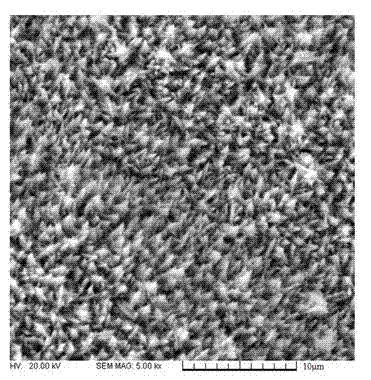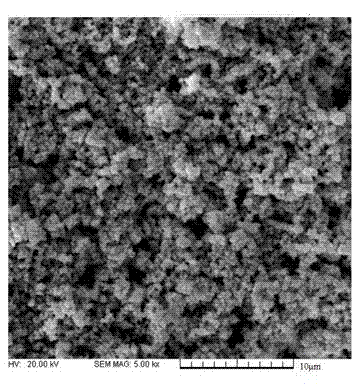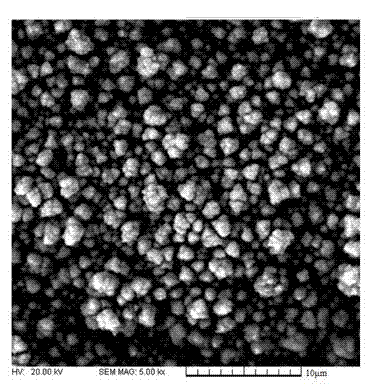Preparation method of curved surface electrode catalyst layer
An electrode catalyst layer and catalyst technology, applied in battery electrodes, circuits, electrical components, etc., can solve the problems of limited utilization of noble metal catalysts, increased catalyst crystal particle size, catalyst agglomeration, etc., to increase the electrochemical active area, Effect of reducing catalyst particle size and eliminating dendritic growth
- Summary
- Abstract
- Description
- Claims
- Application Information
AI Technical Summary
Problems solved by technology
Method used
Image
Examples
preparation example Construction
[0030] The preparation method of the curved surface electrode catalyst layer is characterized in that it comprises the following steps:
[0031] The first step: pretreatment of the electrode substrate, which is used to remove a small amount of grease and metal oxides attached to the surface of the electrode substrate. The electrode substrate can be a graphite rod or a carbon rod or other conductive rods; the specific method can be used: put the electrode substrate into a concentration of In the alkaline solution of 0.1-5 mol / L, the alkaline solution can be sodium hydroxide NaOH or potassium hydroxide KOH solution; the temperature of the solution is controlled by a constant temperature magnetic stirrer at 25-100°C and stirred to remove the electrode matrix For the trace amount of grease attached to the surface, take out the electrode substrate after 5 to 120 minutes, rinse it with deionized water, and then put the electrode substrate in an acidic solution with a concentration of...
Embodiment 1
[0042] Step 1: Immerse a graphite rod with a diameter of 0.5 mm into a sodium hydroxide NaOH solution with a concentration of 1 mol / L, use a constant temperature magnetic stirrer to control the temperature at 80 °C, and stir; take out the graphite rod after 30 minutes, and use Rinse it repeatedly with deionized water and dry it in the air; then immerse it in a dilute hydrochloric acid HCl solution with a concentration of 1 mol / L, and stir it in the same way. After 3 hours, remove the graphite rod, rinse it with deionized water, and place it in the Dry in the air for later use;
[0043] The second step: the pretreated graphite rod is placed in the electrochemical deposition tank, and the electroplating solution containing the catalyst cation is filled in the electrochemical deposition tank, and the electroplating solution is dissolved in dilute hydrochloric acid with a concentration of 1 mol / L Palladium chloride PdCl with a mass fraction of 1 wt.% 2 solution; use graphite rod ...
Embodiment 2
[0049] Step 1: Immerse a carbon rod with a diameter of 1.0 mm into potassium hydroxide KOH solution with a concentration of 5 mol / L, use a constant temperature magnetic stirrer to control the temperature at 25 °C, and stir; take out the carbon rod after 10 minutes, and use Rinse it repeatedly with deionized water and dry it in the air; then soak it in 5 mol / L dilute sulfuric acid H 2 SO 4 The solution was also stirred, and after 2 hours, the carbon rod was taken out, rinsed with deionized water, and dried in the air for subsequent use;
[0050] The second step: the carbon rod is placed in the electrochemical deposition tank, and the electroplating solution containing the catalyst cation is filled in the electrochemical deposition tank. The electroplating solution is dissolved in dilute hydrochloric acid with a concentration of 3 mol / L and the mass fraction is 3 wt.% of chloroplatinic acid H 2 PtCl 6 solution; using carbon rod as the working electrode, forming a three-electr...
PUM
| Property | Measurement | Unit |
|---|---|---|
| diameter | aaaaa | aaaaa |
Abstract
Description
Claims
Application Information
 Login to View More
Login to View More - R&D
- Intellectual Property
- Life Sciences
- Materials
- Tech Scout
- Unparalleled Data Quality
- Higher Quality Content
- 60% Fewer Hallucinations
Browse by: Latest US Patents, China's latest patents, Technical Efficacy Thesaurus, Application Domain, Technology Topic, Popular Technical Reports.
© 2025 PatSnap. All rights reserved.Legal|Privacy policy|Modern Slavery Act Transparency Statement|Sitemap|About US| Contact US: help@patsnap.com



